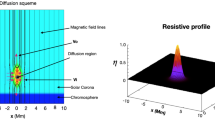Abstract
Viscous effects are expected to significantly contribute to reconnective energy release mechanisms in solar flares. While simple scaling arguments based on head-on reconnection suggest that viscous dissipation may dominate resistive dissipation, it is not clear whether these findings can be applied in more general merging situations. Here we perform side-by-side planar reconnection simulations driven by the Orszag–Tang vortex, for both classical and Braginskii forms of the viscosity. This formulation has the advantage of providing an autonomous MHD system that develops strong current layers, sustained by large-scale vortical shearing flows. The dissipation rates are shown to follow analytically based scaling laws, which suggest that viscous losses generated from large-scale non-uniform velocity fields are likely to dominate resistive losses in current-sheet reconnection solutions.





Similar content being viewed by others
References
Armstrong, C.K., Craig, I.J.D., Litvinenko, Y.E.: 2011, Viscous effects in time-dependent planar reconnection. Astron. Astrophys. 534, A25. doi: 10.1051/0004-6361/201117657 .
Biskamp, D.: 1993, Nonlinear Magnetohydrodynamics. Cambridge Monographs on Plasma Physics, Cambridge University Press, Cambridge. doi: 10.1017/S0022112094214167 .
Biskamp, D.: 1994, Magnetic reconnection. Phys. Rep. 237, 179 – 247. doi: 10.1016/0370-1573(94)90110-4 .
Biskamp, D., Schwarz, E., Drake, J.F.: 1995, Ion-controlled collisionless magnetic reconnection. Phys. Rev. Lett. 75, 3850 – 3853. doi: 10.1103/PhysRevLett.75.3850 .
Braginskii, S.I.: 1965, Transport processes in a plasma. Rev. Plasma Phys. 1, 205.
Craig, I.J.D., Fabling, R.B.: 1996, Exact solutions for steady state, spine, and fan magnetic reconnection. Astrophys. J. 462, 969. doi: 10.1086/177210 .
Craig, I.J.D., Litvinenko, Y.E.: 2009, Anisotropic viscous dissipation in three-dimensional magnetic merging solutions. Astron. Astrophys. 501, 755 – 760. doi: 10.1051/0004-6361/200911784 .
Craig, I.J.D., Litvinenko, Y.E.: 2010, Energy losses by anisotropic viscous dissipation in transient magnetic reconnection. Astrophys. J. 725, 886 – 893. doi: 10.1088/0004-637X/725/1/886 .
Craig, I.J.D., Litvinenko, Y.E.: 2012, Inflow reconnection solutions in incompressible visco-resistive plasmas. Astrophys. J. 747, 16. doi: 10.1088/0004-637X/747/1/16 .
Craig, I.J.D., Litvinenko, Y.E., Senanayake, T.: 2005, Viscous effects in planar magnetic X-point reconnection. Astron. Astrophys. 433, 1139 – 1143. doi: 10.1051/0004-6361:20041933 .
Craig, I.J.D., Watson, P.G.: 1999, Dynamic planar magnetic reconnection solutions for incompressible plasmas. Astrophys. J. 516, 924 – 933. doi: 10.1086/307135 .
Craig, I.J.D., Watson, P.G.: 2000, Optimized magnetic reconnection solutions in three dimensions. Solar Phys. 194, 251 – 268. doi: 10.1023/A:1005264813612 .
Dahlburg, R.B., Picone, J.M.: 1989, Evolution of the Orszag–Tang vortex system in a compressible medium. I – Initial average subsonic flow. Phys. Fluids B 1, 2153 – 2171. doi: 10.1063/1.859081 .
Heerikhuisen, J., Craig, I.J.D., Watson, P.G.: 2000, Time-dependent magnetic reconnection in two-dimensional periodic geometry. Geophys. Astrophys. Fluid Dyn. 93, 115 – 142. doi: 10.1080/03091920008203724 .
Hollweg, J.V.: 1986, Viscosity and the Chew–Goldberger–Low equations in the solar corona. Astrophys. J. 306, 730 – 739. doi: 10.1086/164382 .
Kowal, G., Lazarian, A., Vishniac, E.T., Otmianowska-Mazur, K.: 2009, Numerical tests of fast reconnection in weakly stochastic magnetic fields. Astrophys. J. 700, 63 – 85. doi: 10.1088/0004-637X/700/1/63 .
Lifshitz, E.M., Pitaevskii, L.P.: 1981, Physical Kinetics. Course of Theoretical Physics, Pergamon Press, Oxford.
Litvinenko, Y.E.: 2005, Viscous energy dissipation by flux pile-up merging in the solar corona. Solar Phys. 229, 203 – 212. doi: 10.1007/s11207-005-6882-5 .
Litvinenko, Y.E., Craig, I.J.D.: 1999, Magnetic energy release in flux pile-up merging. Solar Phys. 189, 315 – 329. doi: 10.1023/A:1005258504535 .
Litvinenko, Y.E., Craig, I.J.D.: 2003, Robust scalings in compressible flux pile-up reconnection. Solar Phys. 218, 173 – 181. doi: 10.1023/B:SOLA.0000013041.22847.bb .
Orszag, S.A., Tang, C.M.: 1979, Small-scale structure of two-dimensional magnetohydrodynamic turbulence. J. Fluid Mech. 90, 129 – 143. doi: 10.1017/S002211207900210X .
Park, W., Monticello, D.A., White, R.B.: 1984, Reconnection rates of magnetic fields including the effects of viscosity. Phys. Fluids 27, 137 – 149. doi: 10.1063/1.864502 .
Priest, E., Forbes, T.: 2000, Magnetic Reconnection: MHD Theory and Applications, Cambridge University Press, Cambridge.
Acknowledgements
The authors would like to thank Yuri E. Litvinenko for his assistance with the article. Conversations with E. Kalnins have also been much appreciated.
Author information
Authors and Affiliations
Corresponding author
Rights and permissions
About this article
Cite this article
Armstrong, C.K., Craig, I.J.D. Visco–Resistive Dissipation in Transient Reconnection Driven by the Orszag–Tang Vortex. Sol Phys 283, 463–471 (2013). https://doi.org/10.1007/s11207-013-0226-7
Received:
Accepted:
Published:
Issue Date:
DOI: https://doi.org/10.1007/s11207-013-0226-7




